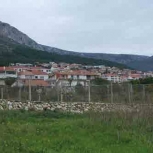
Solin
Solin is a growing city in terms of population and land use. The city is faced with population pressure, especially from young families. It is a reflection of the situation in the entire agglomeration of Split, which Solin is a part of.
Housing is cheaper and therefore more appealing than in the agglomeration centre and neighbouring city of Split. This has been a long-term trend. The majority of private housing, which is predominant in Solin, was built illegally. A legalisation process was initiated under the government campaign over the last two years.
Some parts of the city are extremely dense while others are not, mainly for four reasons: (1) the vast archaeological site of Roman Salona (historic city centre) is not a building zone, (2) there are hectares of protected green belts in the city outskirts, (3) distant areas are less appealing for housing purposes because of the poor transportation infrastructure, and (4) there are huge industrial and brownfield areas in need of reconversion. Highly aware that the options for further sustainable urban development are limited due to administrative and natural restrictions, the city of Solin is grasping at the chance to change the physical, social and economic trends in the city in order to put a halt to the urban sprawl. This is also an opportunity to work on defining the identity of the small city within the bigger functional area.


